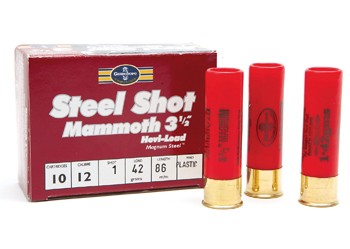Steel shot wildfowling cartridges review

Steel shot wildfowling cartridges review
Steel shot wildfowling cartridges: Wildfowlers like me have been waiting ages to give 3½in super-magnum steel loads a blast on the foreshore.
Our American cousins have been banging away with ’em for several years of course, but it’s only now that the proof authority for Europe (CIP) has given such heavy-duty cartridges in 12 and 10-bore sizes the green light here.
The nearest we’ve been are High Performance 3in shells carrying a lighter payload that can only be fired through guns proofed for steel shot and stamped with a Fleur de Lys symbol.
They’re okay, to a point, but if you want to shoot geese and duck at longer distances you need to follow the American example which stipulates heavier loads of larger steel shot flying at faster speeds than we’re currently used to.
For instance this could amount to 13/4oz (44 gm) of BB or T shot (American sizes) fired from a 3½in 12-bore ‘Super Magnum’ cartridge.
The 10-bore opens up even greater possibilities. Given what we see on American hunting videos and You Tube there can be no doubt that the right steel load can kill giant Canada geese, dead in the sky, even at long distances.
I am a big fan of these Supermag shells and I have been disappointed by the lack of availability of these goose-busters from our main UK cartridge manufacturers. Only Gamebore with its ‘Mammoth Steel’ load has come up with a 3½in Supermag for my Xtrema to eat up.
However, Remington, Winchester and Clever Mirage all produce and distribute a variety of Supermag steel shot cartridges in the UK, albeit that they are sometimes difficult to obtain from stock at the gun shop.
Why can they import cartridges to us but we are not producing them ourselves, I asked?
At 65p-£1 a bang (rrp) these imported Supermags can hit the pocket compared to the UK-made 3in shells which cost about 26 pence a go!
Surely the new regulations, agreed by CIP will now mean our UK based steel shotgun cartridge manufacturers can start to churn out the Super- Duper-Goose-Busting-Loads which our American friends have been enjoying all this time?
And surely, this extra competition in the UK market will be a good thing for wildfowlers, too?
As I say, only Gamebore produces a 3½in jobbie so if proof regulations are no longer a problem, what is stopping UK cartridge companies from loading the shells I want?
According to Brian Jackson at Lyalvale Express it is simply down to market forces – with several different brands already available, the volume of use of these shells on Britain’s foreshores won’t allow further expansion of the market.
Brian believes that changes in the value of the pound in the US and Canada and market growth for steel loads elsewhere in northern Europe would help the situation.
If it does, companies like Lyalvale have the machines and component parts to produce top-quality Super Magnum shells that meet the regulations as long as the market is right.
Brian points to Denmark as an example of somewhere that is bucking the American trend with hunters demanding light 1oz cartridges loaded into 3in cases which are able to leave the gun at high speed.

ABOVE: This brace of greylags fell to a standard steel 3in magnum load.
Those producing 1520 fps (V2.5m) are extremely popular. While these loads are under the momentum of 15 Newtons required by the CIP for 3inch loads, they do exceed the velocity limit. For this reason, while Lyalvale Express produces ‘Fast Steel’ 28gram 3inch cartridges it can only offer this product in non CIP regulated countries such as Denmark.
The debate will continue.
Lyalvale’s interest in the steel shot market led them to release a new product to the UK last year, the (High Performance) ‘Supreme Steel’ in 32grams at 1380fps (1425fps Muzzle velocity) 4 shot only.
You can see from the picture that this is a top quality shell with a huge 25mm brass head and gold print. I suspect this cartridge is targeting driven game shots using modern guns, but a larger shot size may be needed to consistently kill high ducks and pheasants.
Whatever its intended purpose it will be a useful trick in the wildfowlers’ toolbox, especially for shooting over decoys.
What interests me is that both Brian, and Roger Hancox, master of the Birmingham Proof House agree that CIP missed an opportunity by basing steel cartridge regulations on a ‘bottom up’ principle.
The international proof authority set the limits of velocity and momentum in order to make sure that the cartridge did not damage the gun. Instead, it should’ve used appropriate science to decide what non-toxic load can reasonably and ethically be expected to kill our quarry at responsible range, 90% of the time.
Having established that, it could have then worked back to make sure modern guns are built to withstand the use of those cartridges. In other words the onus would be on the hunter to buy a new gun if his or her current one, was not fit for purpose.
Top and bottom of all this is that market forces are limiting the manufacture of extended ranges of ‘wildfowlerish’ cartridges in the UK, as the market here is not big enough.
So if you want to see more British Bangers on the foreshore, start buying and experimenting with big steel loads and tell your gunsmith you want more!
I can’t fault them.








